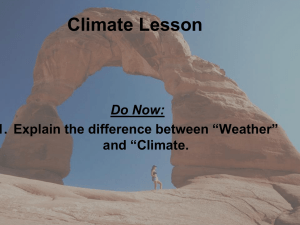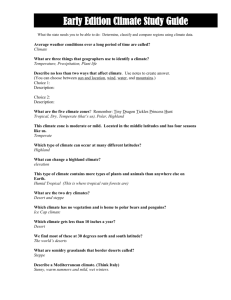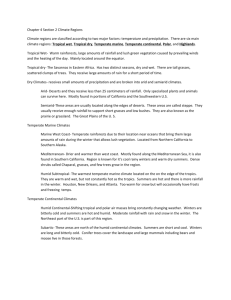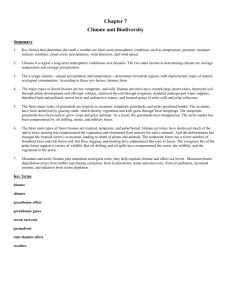Test A3 : Vegetation & ecosystem
advertisement
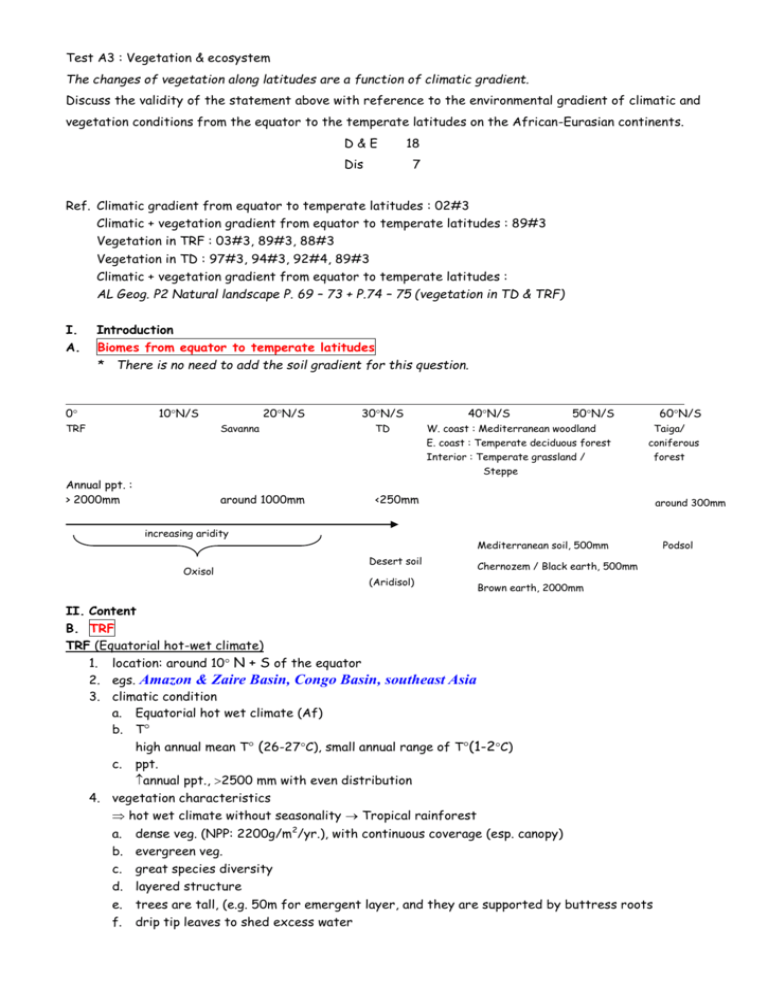
Test A3 : Vegetation & ecosystem The changes of vegetation along latitudes are a function of climatic gradient. Discuss the validity of the statement above with reference to the environmental gradient of climatic and vegetation conditions from the equator to the temperate latitudes on the African-Eurasian continents. D&E Dis 18 7 Ref. Climatic gradient from equator to temperate latitudes : 02#3 Climatic + vegetation gradient from equator to temperate latitudes : 89#3 Vegetation in TRF : 03#3, 89#3, 88#3 Vegetation in TD : 97#3, 94#3, 92#4, 89#3 Climatic + vegetation gradient from equator to temperate latitudes : AL Geog. P2 Natural landscape P. 69 – 73 + P.74 – 75 (vegetation in TD & TRF) I. Introduction A. Biomes from equator to temperate latitudes * There is no need to add the soil gradient for this question. 0 10N/S 20N/S 30N/S TRF Savanna TD Annual ppt. : > 2000mm around 1000mm <250mm 40N/S increasing aridity Oxisol 50N/S W. coast : Mediterranean woodland E. coast : Temperate deciduous forest Interior : Temperate grassland / Steppe 60N/S Taiga/ coniferous forest around 300mm Mediterranean soil, 500mm Desert soil (Aridisol) Chernozem / Black earth, 500mm Brown earth, 2000mm II. Content B. TRF TRF (Equatorial hot-wet climate) 1. location: around 10 N + S of the equator 2. egs. Amazon & Zaire Basin, Congo Basin, southeast Asia 3. climatic condition a. Equatorial hot wet climate (Af) b. T high annual mean T (26-27C), small annual range of T(1-2C) c. ppt. annual ppt., 2500 mm with even distribution 4. vegetation characteristics hot wet climate without seasonality Tropical rainforest a. dense veg. (NPP: 2200g/m2/yr.), with continuous coverage (esp. canopy) b. evergreen veg. c. great species diversity d. layered structure e. trees are tall, (e.g. 50m for emergent layer, and they are supported by buttress roots f. drip tip leaves to shed excess water Podsol C. Savanna Savanna / Tropical grassland (Tropical wet dry climate) 1. location : 10 & 20 N/s of the equator 2. egs. the Campos (Brazilian Highlands) + most of central Africa surrounding the Zaire Basin 3. climatic condition a. Tropical wet dry climate (Aw) b. T short & cooler season when the sun is overhead at the tropics in the opposite hemisphere + greater range of T compare with TRF c. ppt. lower ppt. ; 1000mm annually, with distinct dry season 4. vegetation characteristics tropical wet dry climate tropical grassland (shrubs + grasses dominate) With the presence of dry season + lower ppt. a. lower NPP: 900 g/m2/yr b. lower species diversity c. leave shedding in dry season d. trees are shorter e. grass dominates + vegetation shows xerophytic adaptation as getting closer to the TD D. Tropical Desert Tropical desert (Tropical hot dry climate desert soil / aridisols) 1. location : 20-30N / S of the equator 2. egs. Sahara D, Namib D, Great Australian D 3. climatic condition a. Tropical hot dry climate (B) b. T annual mean; annual range of T ( > 50C) c. ppt. annual ppt. ; < 250 mm 4. vegetation characteristics tropical hot dry climate sparse desert scrub/ shrub a. lowest NPP = 90g/m2/yr. b. sparse, discontinuous coverage c. annuals / drought evaders, e.g. Gama grass germinates seeds within 4 weeks after rain d. perennials / drought resisters, possess anatomical, morphological + spatial adaptation to aridity e. anatomically, vegetation is halophytic, e.g. saltbush; succulent, e.g. suguaro cactus; able to adjust cell-sap concentration f. structurally, vegetation is low in height; with small, hairy leaves, e.g. Ocotillo of SW America, Acacia; low shoot to root ratio (1:35 to 1:20); with long tap roots, i.e. phreatophytes, e.g. American mesquite trees (30m) g. spatially, vegetation is sparse + scattered to minimize competition for water; often found in areas with rivers or high water table, e.g. oasis E. Mediterranean woodland Mediterranean woodland (Warm temperate western maritime climate / Mediterranean climate) 1. location : 30 – 40 N/S of the equator, w. coast of mid-latitudes 2. egs. Mediterranean Europe, California + central Chile 3. climatic condition a. Warm temperate western maritime climate (Cs) b. T hot dry summer + warm/ mild wet winter c. moderate ppt., around 500 mm annually, concentrates in winter 4. vegetation characteristics Warm temperate western maritime climate open woodland with broad-leaved, evergreen trees and conifers a. lower NPP = 700g/m2/yr. b. dense, continuous shrub + evergreen oak woodland F. Temperate deciduous forest Temperate deciduous forest (Cool temperate western maritime climate) 1. location : 40 - 60N/S (w. coast of continent) 2. egs. : NW Europe, NW U.S.A., Tasmania, N. Island of New Zealand 3. climatic condition a. Cool temperate western maritime climate (Cfb) b. T cool summer (15- 17C) + warm winter (around 10C); small annual range of temperature c. ppt. high ppt. , > 2000 mm falls throughout the yr. with winter maxima 4. vegetation characteristics Cool temperate western maritime climate (wetter, annual ppt. > 2000mm) deciduous forest a. higher NPP: 1200g/m2/yr. b. deciduous vegetation G. Temperate grasslands / Steppe Temperate grasslands / Steppe (Cool temperate continental climate) 1. location : 40-60N/S (continental interior) 2. egs. N. American Prairies; The Pampas (S. America), Murray-Darling Basin 3. climatic condition a. Cool temperate continental climate b. T large annual range of T, up to 40C ∵clear sky warm summer (20C) + cold winter (0C for 5 months) c. ppt. low to moderate ppt., 500mm annually; concentrating in summer 4. vegetation characteristics temperate continental climate (annual ppt. 600 mm) temperate grassland a. lower NPP: 600g/m2/yr. due to drier condition b. drier condition supports grassland instead of forest c. lower species diversity d. lower density H. Other factors affecting vegetation growth 1. Topographic factors a. altitude / height b. slope / gradient c. aspect 2. Edaphic factors / soil 3. Biological factors * Human impact : devegetation / deforestation vs. afforestation (Australia)


